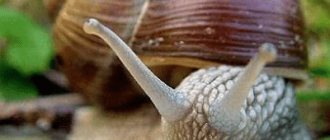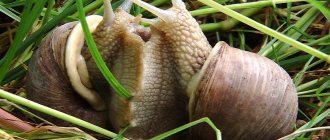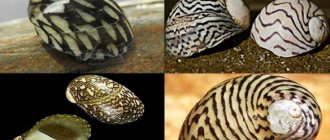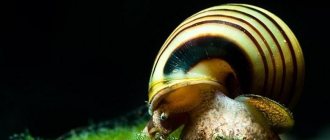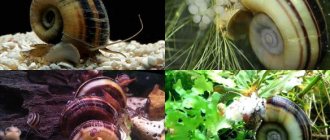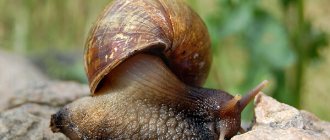Roman legionaries took them with them on long campaigns as natural canned food; medieval monks planted vegetable gardens in the monastery gardens to supplement their meager Lenten diet; European colonialists, both in hot Africa and on the distant Antilles, did not want to give up their favorite delicacy. Not without the help of the French grape snail (Helix pomatia) came to Russia in the 18th century.
- Where is the grape snail found?
- What does a grape snail look like?
- Where in nature can you find snails? Features of snail ecology
- Breeding snails in artificial conditions
Where is the grape snail found?
True, it has spread mainly in the southern regions, where the conditions for its development are most favorable. In the middle zone there are only local populations associated mainly with humans. It is believed that breeding grape snails is economically profitable even in our climatic conditions. At relatively low costs, this activity can provide a significant economic effect in a short time. Moreover, both schoolchildren and pensioners with a small garden plot can breed snails. In Moscow, many restaurants are happy to purchase this delicious product.
Grape snail
Description
Character and lifestyle of the snail
Snail activity manifests itself in warm times: from the beginning of spring until autumn frosts. During the cold period, they fall into suspended animation, or hibernation. The rest period lasts up to 3 months. For wintering, mollusks prepare chambers in the soil.
Being good diggers, they make indentations with their muscular legs. The depth is from 6 to 30 cm depending on the density of the soil and other conditions. If the snail cannot burrow into hard ground, it hides under the leaves.
The mouth of the snail shell is covered with a special film of mucus, which, after hardening, turns into a dense cap. A small vent is maintained for air flow.
You can check this by immersing the snail in water - bubbles will appear as evidence of gas exchange. The thickness of such a plug depends on wintering conditions. The calcareous shell reliably protects the body of the mollusk from the external environment. During hibernation, weight loss reaches 10%, and recovery lasts for a month after awakening.
A hibernating snail always lies with its mouth facing up. This allows you to maintain a small air layer, protects against bacteria and makes it easier to wake up in the spring. In order not to be flooded, she needs to get to the surface as quickly as possible in a few hours.
During the day, mollusks are passive, hiding in inconspicuous places under the cover of leaves or stones, on damp soil or damp moss. Air humidity affects the behavior of snails.
In dry weather, they are lethargic and inactive, sitting in shells covered with a transparent veil from evaporation and dehydration. On rainy days, the snail comes out of hibernation, eats the protective film at the mouth of the shell, the speed of its movement increases, and the period of active search for food increases.
An interesting fact is the regeneration, or restoration, of missing body parts by snails. If a predator bites off the tentacles or part of the head of a mollusk, the snail will not die, but will be able to regrow what is missing within 2-4 weeks.
Breeding grape snails at home
today it has not become a rarity.
This explains that in a number of countries, despite bans on the import of shellfish, interest in them remains and the price of grape snails
is rising.
Appearance
The body, like that of all representatives of the class, is externally divided into a shell and a trunk. In the latter, the leg and head are distinguished. The internal organs are surrounded by a mantle, part of which is visible from the outside.
Sink
The diameter of the shell of an adult is on average 3-5.5 cm; its volume is sufficient to completely accommodate the entire body. The shell is spirally curved; has 4.5 (sometimes 5) turns lying in different planes (the so-called turbo spiral
); twisted to the right; spins clockwise. Such shells are called dexiotropic, right-handed.
The shell color varies from yellow-brown to brown-white. Along the entire length of the first 2-3 whorls there are 5 dark and 5 light stripes. The shell color of some individuals is darker, while others are lighter. The color saturation depends on the habitat and is related to the intensity of lighting and the background of the environment, that is, it helps camouflage. The color of the shell may change depending on what food the individual eats.
The shell is ribbed. This increases the surface area, allowing more moisture to accumulate. The ribs also give the sink greater strength and, in addition, thanks to them, the sink weighs less.
Leg and torso
The usual leg length of an adult is 3.5-5 cm, but the animal can stretch out greatly, up to 8-9 cm.
The body of a grape snail is very elastic. Its color varies among different individuals, as does the color of the shell. Usually the body color is beige with a brown tint, less often dark gray. It has its own special pattern. In some cases, snails lack such a pattern or it is almost invisible, so the color of their legs is monochromatic. Body color can change in one individual when it eats different foods.
The body is completely covered with wrinkles, the areas between them look like quadrangles. Wrinkles increase the surface area of the leg and retain moisture.
Tentacles
There are two pairs of tentacles above the snail's mouth. The length of the anterior tentacles - labial - ranges from 2.5 to 4.5 mm. They have an olfactory function. The length of the rear tentacles - the eye ones - is from 1 to 2 cm. At the end of the latter there are eyes, all of whose receptors contain the same photopigment, which is the cause of color blindness of the animal. However, the eyes are capable of not only distinguishing the intensity of light, but also seeing objects at a distance of up to 1 cm.
The tentacles are very mobile. The rear ones can be located relative to each other at an angle greater than the unfolded one. The front tentacles are less mobile, changing position only in the vertical direction, lowering and rising; usually form an obtuse angle with each other. Both pairs are very sensitive: if accidentally touched by an object, the tentacles instantly retract inward. The eye tentacles also react negatively to very bright light.
Internal structure
Like all members of the class, the digestive system of the grape snail is divided into an ectodermal foregut and an endodermal midgut. Breathing is pulmonary. The heart, located above the hindgut, consists of the left atrium and ventricle and is surrounded by the pericardium. Blood is colorless. The nervous system is scattered and nodular, consisting of several ganglia. The excretory system consists of one kidney, one end communicating with the pericardium, and the other opening into the mantle cavity next to the anus. The reproductive system is hermaphrodite, cross-fertilization.
What does a grape snail look like?
Everyone knows what snails look like. Grape plant is one of the largest in our country. The spirally curved shell (up to 50 mm high and wide) protects the soft body of the mollusk from mechanical damage and enemies, of which it has many: hedgehogs, mice, birds, and predatory insects. If a snail lives in a humid environment, its shell is dark and relatively soft; in a dry environment, it is lighter and harder. The body is asymmetrical, with a clearly visible head and a wide, flat leg. On the head there are two pairs of tentacles, which are often called horns. In fact, these are sense organs: the lower pair are the senses of smell and taste, and the upper pair are the eyes. With the help of a muscular leg, the mollusks move smoothly, sliding on a sole covered with mucus. In dry summers, snails are lethargic and inactive.
They climb into the sink and are fenced off from the environment with a thin film, which minimizes the evaporation of water from the body, but allows air to pass through. But as soon as the rains begin or heavy dew appears, the snails break through the film and begin active activity.
Aphrodite's Pearl
Another delicacy is snail caviar: snow-white shellfish eggs with a diameter of 3-5 mm.
They resemble small white pearls with the taste and smell of moss and noble mushrooms. In terms of chemical composition, snail caviar is closest to sturgeon caviar. It contains 36 useful microelements. For the heart, blood vessels and thyroid gland - the best support. By introducing it into the menu, it is easy to reduce weight: 100 g - 90 kcal and 16 g of protein. Therefore, it is recommended for obesity and lipid metabolism disorders. Europeans call snail caviar the pearls of Aphrodite: it is such a strong aphrodisiac.
To collect caviar, the couple prepares a special bed for the snails - containers with peat. One of the most important characteristics of the soil is its acid-base balance, which should be in the range of 3.5-4.5 pH. Snails are hermaphrodites, each individual has characteristics of both sexes. But this does not mean that they reproduce on their own. They still need a partner. Having found each other, the future parents start a wedding. They circle for hours, touching their antennae and lightly biting each other. And at the same time they do not make a sound to lure a partner. The fact is that snails are not able to hear at all. Having finished courtship, the partners go in different directions. A week or two after mating, the snails crawl into the container and lay 100-180 eggs in it.
The appearance of offspring takes from 2 weeks to 2 months. The more favorable the conditions, the faster the tiny clams will form. Eggs with viable offspring are pure white. Then tiny snails emerge from them with a fragile shell, which after months turns into a cozy, durable house.
To collect caviar as a delicacy, it is necessary to remove the caviar immediately after laying and wash it in cold running water without damaging the shell. In Europe, this delicacy is highly valued: the price for 1 kg reaches 1,700 euros.
Pavel also learned how to salt snail caviar. When salting, he uses only salt, and sea salt. If you add something to caviar, it immediately changes color, becoming beige or pink.
Where in nature can you find snails? Features of snail ecology
In nature, they live in broad-leaved forests, meadows, ravines, lightly shaded gardens, parks overgrown with bushes. A prerequisite is chalk or limestone soil. In dry weather they hide under stones, in the shade of plants or in damp places. They spend the day hiding in the shell, and come out to feed only at night.
Grape snail
Their food is the leaves and stems of many plants: strawberries, plantain, horse sorrel, dandelion, lungwort, burdock, nettle, horseradish, cabbage, raspberry, clover, fireweed, bedstraw, etc. They also eat fruits, including including rotten ones, and leaf litter. A large number of grape snails can harm plants in the garden and garden. But the gardens of the middle zone are not in such danger. Although this is a fairly prolific species of terrestrial mollusks, in our climatic conditions its fecundity is poorly realized. Only with artificial cultivation do they more fully realize their potential.
Having accumulated reserves of nutrients over the summer, snails begin to prepare for a long winter, which lasts from September-October to mid-April or the first ten days of May. The signal is a drop in air temperature to +12°C. Snails burrow into the soil to a depth of 5–10 cm, and in cold regions - to a depth of up to 35 cm. Covered on top with fallen leaves and then snow, they are not afraid of frost. The maximum lifespan of a grape snail under natural conditions does not exceed seven to nine years.
Grape snails are hermaphrodites. But, despite their bisexuality, the courtship ritual of these animals is beautiful and even funny. Both mollusks become “facing” each other so that the soles of their feet touch, stretch horizontally and shoot at each other “love arrows,” sharp calcareous formations about 1 cm long. Two weeks after mating, the snails lay about forty mother-of-pearl eggs in the dug a hole in the ground (to a depth of 3–4 cm). The mollusk spends about twenty hours building a nest. The finished masonry is covered with earth. The incubation period is two to four weeks.
Grape snail
The process of reproduction and breeding of offspring
The mating process begins with the partners touching their tentacles. Courtship can last several hours. When starting to have intercourse, grape snails envelop the leg with a slimy mass and press their bodies tightly against each other. Each hermaphrodite snail shoots arrows filled with spermatozoa into its partner. After the process is completed, the individuals scatter in different directions. The eggs in their bodies begin to form into eggs, dressed in a shell, which the grape snail subsequently lays in moist soil. During one mating, one mollusk can lay up to 400 eggs. After this, the parent leaves the offspring to their fate and crawls away. This behavior is normal, since over the summer she will be able to lay several tens of thousands more embryos.
Breeding snails in artificial conditions
Breeding snails in artificial conditions is a guarantee of stable and environmentally friendly products. You can breed them in different ways. In open areas there are “snail gardens” and enclosures: the fenced area is sown with clover, legumes, rapeseed, sunflower, Jerusalem artichoke or other forage plants. When they grow a little, adult snails are released. Mandatory conditions are a sufficient amount of food, a certain humidity and the presence of chalk or lime. In the same area, grape snails overwinter and breed.
Another method is mixed rearing, when incubation of eggs and rearing of young take place indoors, and rearing takes place in open areas. And finally - completely indoors. This method requires considerable investment. The room for growing snails must be insulated, free of foreign odors, dust, and with controlled temperature and humidity conditions. But this is already a serious production, not for summer residents, but for farms.
By the way, the meat of grape snails contains 70% protein (one third more than in a chicken egg), 10% animal fats, 20% amino acids. And also vitamins and microelements.
Moreover, in such quantities that the pharmaceutical industry of many countries uses snails as raw materials for medicines. It has been established that snail meat contains a high content of biologically active substances that activate life processes and have a rejuvenating effect. Snails are recommended for pregnant women and nursing mothers, children and adults for diseases that require regeneration and strengthening of osteochondral tissue.
Grape snail at home
The grape snail is easy to keep at home. Anyone can handle this task. The main thing is to take care of your pet’s home and food. How to care for a grape snail is described below.
Making a snail's home
Breeding grape snails should start with home improvement. It is best to breed gastropods of this species in aquariums or any large glass containers. Plastic boxes will also work. It is important to provide your pets with good ventilation, otherwise poor air circulation can negatively affect their health. Several times a week you will need to clean the aquarium and remove the mucus that remains on its walls from the snails. The acceptable temperature for keeping gastropods is 23 degrees Celsius. At night the temperature can drop to 19 degrees. The pet's home living conditions should correspond to natural ones.
You can add an area of water to the container so that the snails can bathe in it. Moistened moss will not be amiss. To protect your pet's shell and strengthen it, you can add a little limestone to the tank. The aquarium must be closed with a tight lid. Holes are already made in it for stable air circulation. It is important to take care of the proper level of humidity in the aquarium. As mentioned above, snails do not like drought. Every day you will need to spray water from a regular spray bottle into the container with your pets (preferably 2 times a day).
What to feed
What to feed the grape snail is a common question among breeders. The menu of a grape snail should include all those components that it feeds on in its natural habitat. You can feed your pet pieces of vegetables and fruits, leaves. Humus may also be present in the diet in small quantities. All snail food must be fresh and contain sufficient moisture.
Treatments
It is necessary to ensure that the snail does not damage the shell, so it is worth adopting the following tips:
- It is necessary to feed snails a varied diet that contains a number of vitamins and beneficial additives that have a strengthening effect. It is important that the food is fresh.
- To strengthen the shell, you can give your pets crushed eggshells or other foods that contain large amounts of calcium.
- It is necessary to monitor the bedding soil of the snails. It should not be too dry or overly waterlogged.
- Every day you need to change the water in which your pets bathe.
- As pollution occurs, the underlying soil also changes.
- It is better to place the tank with pets in a cool place, protected from sunlight.
If you monitor the microflora inside the aquarium, you will be able to prevent the development of all kinds of diseases (for example, damage from mites). How long grape snails live depends on the conditions of detention and nutrition.
Reproduction
Grape snails are hermaphrodite creatures that have both male and female reproductive organs. To lay cells, individuals only need to exchange sex cells with any other gastropod. Breeding usually occurs from March to mid-June and from September to October. The transfer of germ cells occurs quickly - it usually takes up to several minutes. After some time, individuals lay eggs with offspring. All of them are in a special protective substance. Next, cocoons are formed from it, from which small gastropods are born.
Eating
Do they eat grape snails ? This is a common question among breeders. Yes, in many countries, gastropod meat is considered a real delicacy. However, many people grow snails for decorative ponds and aquariums. The benefit of grape snails lies in their meat. It contains vitamins and mineral components that normalize the functioning of internal organs. Do not forget about the dangers of grape snails . In some cases, such dishes lead to the development of gastrointestinal pathologies.
Post Views: 116
Content Features
For the safety of your home pond, it is strictly not recommended to introduce snails found in nature into it. In this way, pathogenic organisms can be introduced into it, which will cause diseases of fish and plants. You need to buy shellfish at a pet store, where they meet sanitary standards.
All species of these aquatic inhabitants are unpretentious in keeping, so there is no need to create special conditions for their life and breeding of snails in the aquarium. Considering that the origin of all mollusks is tropical, the water in the aquarium should not be too cold. It is better to maintain a temperature of 24-26 degrees. When temperatures drop to 20 degrees, many species slow down, become less active, or go into hibernation. In water that is too soft, the formation and structure of the shell may be disrupted.
The respiratory system of mollusks is designed so that they can breathe underwater and receive additional oxygen by rising to the surface. Therefore, additional water aeration is not required if there are a sufficient number of plants and few fish in the aquarium.
To wake up a clogged snail, you can pour water over its mouth by carefully removing the cap, or simply place it in a terrarium with normal humidity.
The digestive system of snails works non-stop and quickly, so they eat constantly. They love to feast on fish food. When they see it, they can destroy it all if they have time. Therefore, it is necessary to control the amount of food so that the fish do not go hungry.
Ampullaria, when there is a lack of food, begin to feed on the vegetation of the aquarium. It is better to keep such snails either in aquariums without vegetation or with hard plants, so as not to spoil the beauty of the reservoir. You can additionally feed them with plant foods that fish do not eat: lettuce, grated carrots, cucumber.
Helenas feed on snails and fish eggs. It is necessary to remove eggs from the aquarium on time if you plan to breed fish. If there are no other snails, Helen needs to be fed with bloodworms and shrimp meat. It is better to do this at night, when the fish are inactive, so that predators do not have time to eat first.
What to do with snail clutch
If you find egg laying in the terrarium, take a tablespoon and a plastic bag. Use a spoon to scoop all the eggs into a bag, then put it in the freezer for a few days. Then the bag with eggs can be thrown into the trash.
What to cook from Achatina eggs
From the collected Achatina eggs you can prepare a tasty and unusual dish - snail caviar. In terms of its taste and nutritional qualities, it is not inferior to black caviar, and its unique mushroom aroma will not leave you indifferent. In France, snail caviar is prepared on a special farm, and from there it is exported throughout the world. But you can prepare snail caviar at home, pampering yourself and your loved ones with an exotic delicacy.

